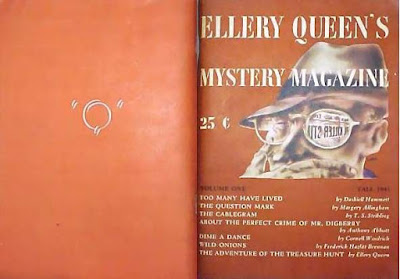By Freeman Wills Crofts (1879-1957).
First appearance: EQMM, May 1953.
Reprinted in EQMM (UK), May 1953 and EQMM (Australia), July 1953.
Short short short story (4 pages).
Online at SFFAudio HERE (PDF).
"The trouble with Herbert Rich was that he was too clever."We won't needlessly repeat Robbie Burns's famous dictum about the best laid plans, but Herbert Rich should have known about it or he wouldn't have contrived a "too clever" plot to do away with Jack Fleet, a wartime pal that Herbert, rightly or wrongly, now regards as a rival for his wife Joan's affections. In this instance, however, unlike so many stories in this mystery subgenre, the killer fails to make allowances, not for the unexpected, but for the perfectly ordinary.
Principal characters:
~ Herbert Rich: A market gardener, "but his real interest lay in photography, at which he was supremely good."
~ Joan Rich: Herbert's young wife and the (probably innocent) second side of a triangle.
~ Jack Fleet: Herbert's "handsome and well-to-do friend" and the hypotenuse in this configuration.
~ Mrs. Tolley: The cook whose predictability will cause a perfectly-knitted murder to unravel.
~ An anonymous police Inspector (who might or might not be named French) who gets the picture.
Comments: One of those "perfect crime" tales that have enjoyed a vogue now and then. Typo: "extingusished" (seriously, Fred?).
Resources:
- Patrick at At the Scene of the Crime has a review HERE of a collection of Freeman Wills Crofts's short stories entitled Murderers Make Mistakes, from which he reproduces this appropriate quote from our author:
So many [murderers] devise ingenious schemes to mislead the police and to avert suspicion from themselves: real brainy schemes which ought to succeed. And then they go and spoil them by some tiny oversight which gives the whole thing away, so that their guilt stands out a mile. It’s like a man who fits up an elaborate electrical system in his house: lights, fires, heaters; every conceivable gadget and convenience, and then spoils it all by forgetting to switch on the current.- Curt Evans has an article about Crofts HERE.
- The normal lineup: Wikipedia HERE, GAD Wiki HERE, FictionMags (about Crofts) HERE and (about Inspector French) HERE, and the ISFDb HERE.
The bottom line: "Seeing a murder on television can help work off one's antagonisms. And if you haven't any antagonisms, the commercials will give you some."
— Alfred Hitchcock









































